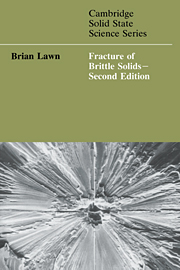Book contents
- Frontmatter
- Contents
- Preface
- Glossary of symbols and abbreviations
- 1 The Griffith concept
- 2 Continuum aspects of crack propagation I: linear elastic crack-tip field
- 3 Continuum aspects of crack propagation II: nonlinear crack-tip field
- 4 Unstable crack propagation: dynamic fracture
- 5 Chemical processes in crack propagation: kinetic fracture
- 6 Atomic aspects of fracture
- 7 Microstructure and toughness
- 8 Indentation fracture
- 9 Crack initiation: flaws
- 10 Strength and reliability
- References and reading list
- Index
6 - Atomic aspects of fracture
Published online by Cambridge University Press: 14 January 2010
- Frontmatter
- Contents
- Preface
- Glossary of symbols and abbreviations
- 1 The Griffith concept
- 2 Continuum aspects of crack propagation I: linear elastic crack-tip field
- 3 Continuum aspects of crack propagation II: nonlinear crack-tip field
- 4 Unstable crack propagation: dynamic fracture
- 5 Chemical processes in crack propagation: kinetic fracture
- 6 Atomic aspects of fracture
- 7 Microstructure and toughness
- 8 Indentation fracture
- 9 Crack initiation: flaws
- 10 Strength and reliability
- References and reading list
- Index
Summary
Until now we have approached crack propagation from the continuum viewpoint. Nonetheless, repeated allusions have been made in chapters 3 and 5 to the fundamental limitations of any such approach that disregards the atomic structure of solids. There we argued for the incorporation of a lattice-plane range parameter as a critical scaling dimension in the brittle crack description. We noted that the Barenblatt cohesion-zone model avoids reference to the atomic structure by resorting to the Irwin slit description of cracks; yet estimates of the critical crack-opening dimensions using this same model confirm that the intrinsic separation process indeed operates at the atomic level. The Elliot lattice half-space model of sect. 3.3.2 represents one attempt to incorporate an essential element of discreteness. The phenomenological kinetic models of sect. 5.5, with their presumption of energy barriers, represent another. However, those models are at the very least quasi-continuous. In brittle fracture, as in any thermodynamic process, the final answers must be sought at the atomic or molecular level.
On the other hand, while an atomistic approach provides greater physical insight into the crack problem, it inevitably involves greater mathematical complexity. Classically, solids may be represented as manybody assemblages of point masses (atoms) linked by springs (bonds). We will see that the mass–spring representation can lead us to a deeper understanding of brittle cracks. But even this representation is oversimplistic. In some cases, particularly when the crack interacts with environmental species, it is necessary to consider atoms as elastic spheres rather than point masses, to allow properly for molecular size effects.
- Type
- Chapter
- Information
- Fracture of Brittle Solids , pp. 143 - 193Publisher: Cambridge University PressPrint publication year: 1993
- 1
- Cited by



